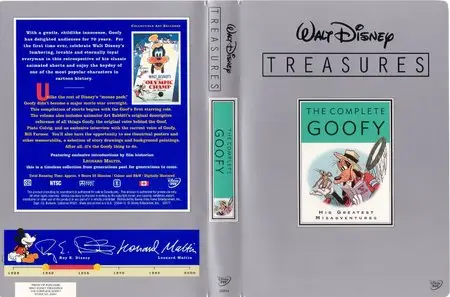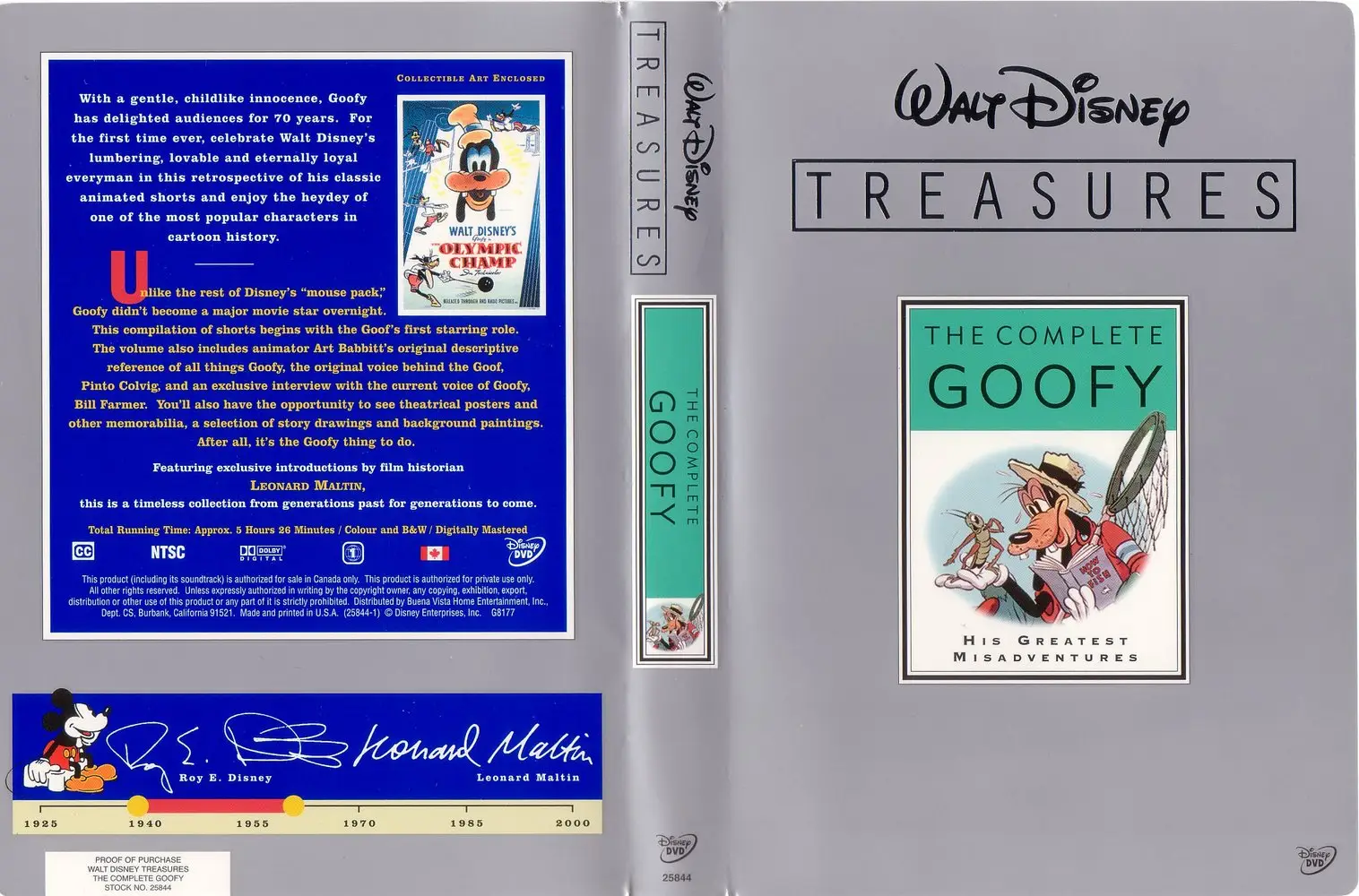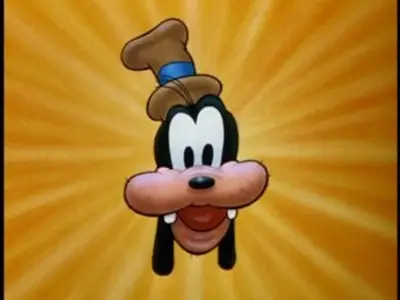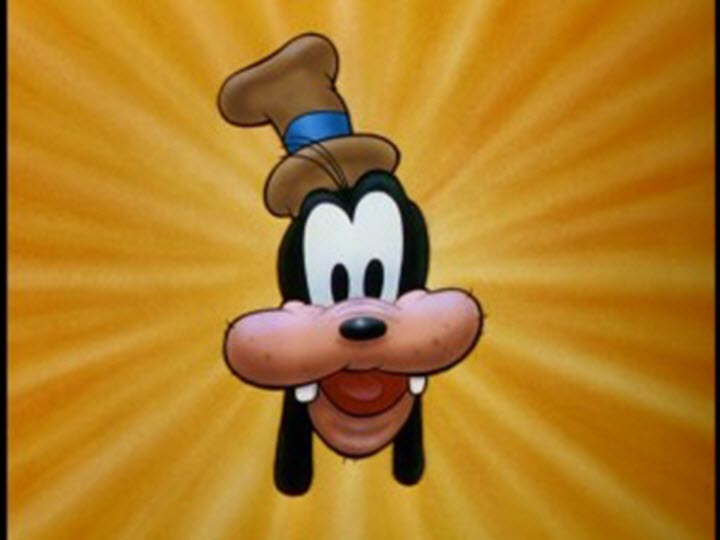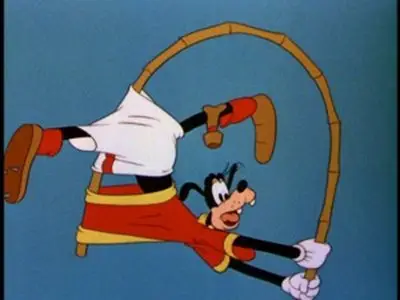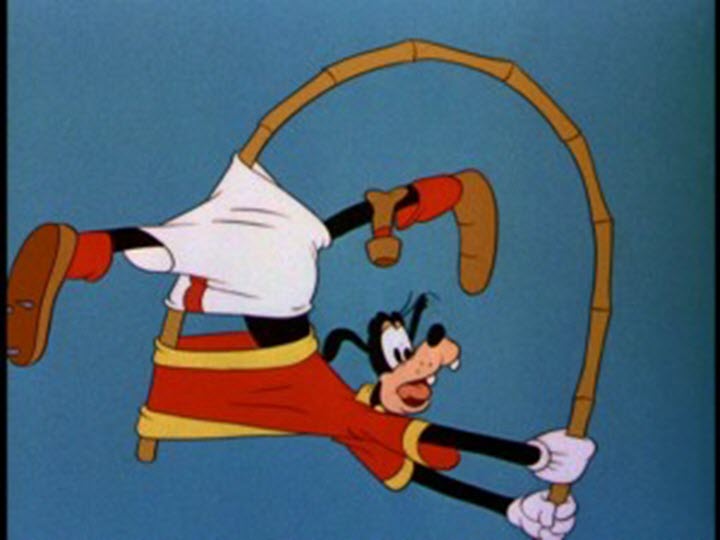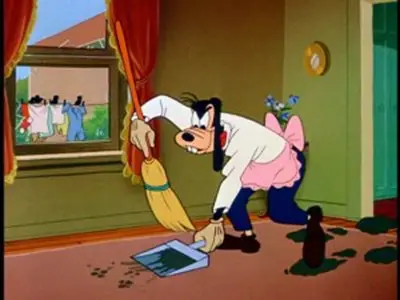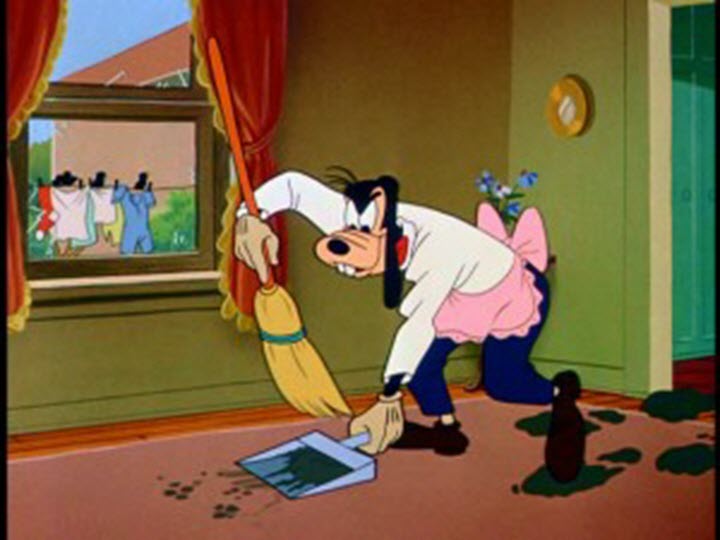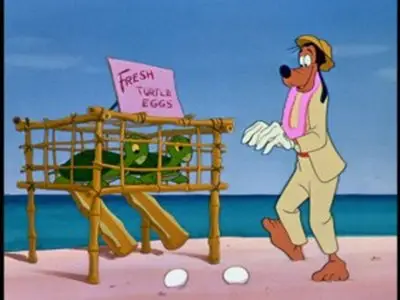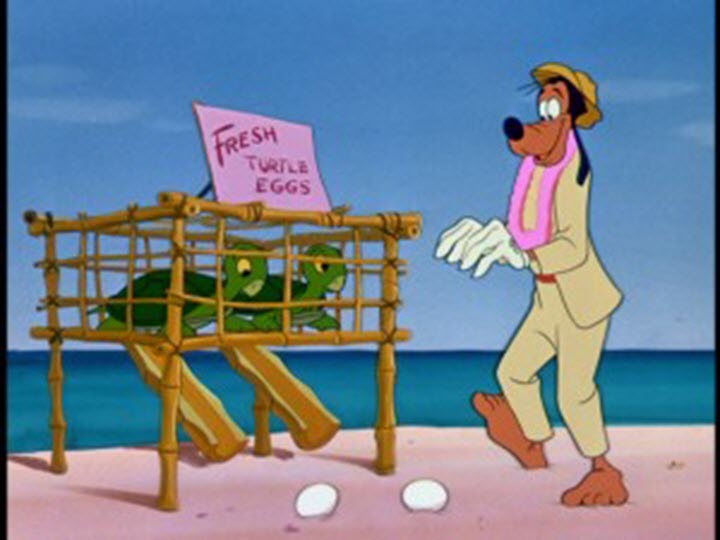Walt Disney Treasures: The Complete Goofy 1938-1961 (2002)
2xDVD9 | Untouched | ISO | NTSC 4:3 1.33:1 720x540 VBR | 5hr 26mn | Colour and B&W | 14.11 GB
Audio: English AC-3 Dolby Digital MONO @ 192 kbps 48.0 kHz | Subtitles: English for Hard of Hearing | Artwork: Covers, Labels, Booklet (JPG)
Extras: Menu, Cartoons Selection, Bonus Features | Genre: Animation, For Children, Comedy, Short, Fantasy, Family | Country: USA
Actors: John McLeish, Hannes Schroll, Pinto Colvig, Kevin Corcoran, John Dehner
Directors: Clyde Geronimi, Dick Huemer, Jack Hannah, Jack Kinney, Wolfgang Reitherman
Writers: Al Bertino, Bill Berg, Bill Peet
Studio: Walt Disney Home Video
DVD Release Date: December 3, 2002
Run Time: 326 minutes
Review By David Willis
Since his introduction more than 70 years ago, Goofy has become one of the most recognized and loved characters of the animated world, being voted in 2005 in Disney's “Golden Ears” survey as the character most people identify with. Yet like his predecessor Mickey Mouse, Goofy has not remained the same all these years; he has undergone countless changes. In his 1932 debut “Mickey’s Revue”, he first appeared with the name Dippy Dawg, which answers a frequently-asked question, “What is Goofy?” He is a dog, however unlike Pluto, Goofy was granted the anthropomorphic features of walking on two legs, wearing clothes and partaking in “human” activities, like his fellow stars Mickey and Donald. It was his
laugh which helped Goofy stand out from the other generic background characters – although it is his yell which many identify with - in the early barnyard shorts, provided by one-time clown Pinto Colvig. Goofy became an instant star and was promoted to appearing alongside Mickey and Donald on many occasions in such classic 1930s shorts as “Clock Cleaners” and “Lonesome Ghosts.”
Despite initially having the official title of Dippy Dawg, to the Disney staff he was always “The Goof.” He demonstrated his Goofy nature by falling victim usually to inanimate objects such as the piano in the 1936 short “Moving Day”, and the shorts would always progress with Goofy trying method after method to achieve his goal, with the methods growing increasingly more farcical. However, due to argument between Walt and Colvig, Colvig left the studio after the production of Snow White and the Seven Dwarfs – for which he had provided two voices – and went to work for Walt’s rival Max Fleischer. Other actors were hired to replicate Colvig’s voice and audio tracks were reused, but it was not the same without him and eventually in 1942 Colvig came back to the Disney studio for good.
The Goofy title card "The Olympic Champ" proves pole vaulting is not as easy as it looks.
As the writers began failing to think of ways to make Mickey fresh, the mouse gradually became eclipsed during the late 1930s by Donald and Goofy, and so in 1939 Goofy was granted his first solo project, “Goofy and Wilbur.” A trademark of the Goofy cartoons, more so than even Donald Duck's shorts, was their use of slapstick and pantomime. In some cartoons, Goofy would not speak and the story progressed from his frustration at the situation, as illustrated by his numerous facial expressions. Goofy’s actions in 1942’s “Goofy’s Glider” were set to narration and became what was the first "how to" short. Exploring Goofy’s attempts to master a given field, the "how to" shorts were a minefield of slapstick, quick action, fanciful designs and endeavors, sight gags, in-jokes, puns and anything else that those involved with the shorts decided to throw in. The ultimate example of this class is 1946’s “Hockey Homicide”, which could easily be described with the word "frenzied." Many of these shorts often featured not one Goofy as we know him, but a whole world filled with Goofys of all shapes and sizes.
The Complete Goofy features 46 shorts originally released between 1939 and 1961 on two discs found inside a double Alpha keepcase. This case is housed within a silver tin, which is imprinted with the number of the individual copy of which 125,000 were made available. Also included is an 8-page booklet which outlines the 46 shorts included as well as bonus features and provides some information about Goofy from Leonard Maltin. Finally, there is a collectible art card reproducing the original theatrical poster for “The Olympic Champ.”
Goofy and his grasshopper friend in "Goofy and Wilbur." Goofy attempts to get airborne in "Goofy's Glider." A skeleton in the trunk from "Baggage Buster."
THE SHORTS
Disc One opens with an introduction by Leonard Maltin (2:17) where he introduces us to the loveable Goofy, gives us a glimpse at the character's evolution and informs of what we will see on this set. This clip can also be selected from the main menu. The shorts can be accessed either in chronological or alphabetical order, although disappointingly, no "Play All" option is provided.
Goofy and Wilbur (1939) (8:08)
After more than a decade of supporting Mickey and Donald, Goofy was finally given the chance to shine on his own, sharing the billing only with Wilbur the grasshopper (in his one and only appearance). The two friends go fishing, with Wilbur being used as the bait in order to lure the fish to Goofy’s net.
Goofy’s Glider (1940) (7:59)
Although the words do not actually appear in the title, this was the first of what are affectionately referred to as the "how to" shorts. Goofy tries to make himself airborne in a glider, attempting various ways to make it take to the sky.
Baggage Buster (1941) (7:33)
Working at a railroad station, Goofy runs into trouble when he has to put a magician’s trunk onto an approaching train. As his inquisitive side gets the better of him, the various props in the trunk – not to mention various animals – do their best to hinder Goofy’s progress.
The Art of Skiing (1941) (7:59)
Pronounced SHEEing as the title card informs us. The various skills and techniques of skiing provide the task which Goofy attempts to tackle amongst snow-covered Alpine mountains, naturally with a soundtrack full of yodelling. Be sure to listen out for the first Goofy scream as he tumbles down the side of a mountain.
The Art of Self-Defense (1941) (7:51)
The survival of the fittest across the ages forms the theme of the next short. We journey through the various civilizations of the world, all with Goofy look-a-like citizens. As we return to the modern age, Goofy attempts various methods of exercise. This is one of the first Goofy cartoons to use slow motion to exaggerate Goofy’s movements.
How to Play Baseball (1942) (8:03)
The rules of baseball, or the "Great American Game" as we are informed, are taught to us in the only way that Goofy can, or should that be Goofys? Two teams full of Goofys take to the field allowing the game to descend into slapstick fuelled chaos.
The Olympic Champ (1942) (7:03)
The Olympics are studied from their beginning in the days of Ancient Greece, naturally cueing a toga-clad Goofy, complete with Olympic torch. As we move forward to the present day, various Olympic events are demonstrated by the Goof.
How to Swim (1942) (7:37)
Beginning with the Goof modelling what was once the latest in bathing suit fashion, Goofy learns how to swim. Naturally, this is not done in a pool, but in the home with the aid of a piano stool.
How to Fish (1942) (7:18)
The cosmic force of Pisces awakens the desire to fish within every man, or at least within every anthropomorphised dog. Goofy ventures into nature – this time without Wilbur the Grasshopper – and is instructed in the various methods of securing a catch.
Victory Vehicles (1943) (9:41 with introduction by Leonard Maltin)
Wartime shortages, in particular the lack of gas and rubber which restricts car use, outline the subject of this short. Transport problems created by the shortages call for innovative homemade solutions to be developed. After seeing many fanciful designs of transportation, powered in various different ways, the answer comes in the shape of the humble pogo stick. The short ends with the catchy ditty "Hop on Your Pogo Stick", which Leonard in his introduction suggests we all demand a CD reissue of.
How to Be a Sailor (1944) (7:08)
The history of sailing through the ages, from the days of Cave Goofs floating on logs to the introduction of the boat and to modern war ships It is perhaps surprising that this short is not preceded by an introduction by Leonard Maltin due to its potentially offensive ending, being a product of the Second World War’s propaganda.
How to Play Golf (1944) (7:42)
"Contrary to popular belief, golf is not a waste of time," this short instructs us. The art of golf is demonstrated by Goofy with the aid of a stick figure, who comes to life to show Goofy the correct techniques of the sport. Unfortunately, playing the ball where it lies leads to the two falling foul of a bull.
How to Play Football (1944) (7:40)
Football is the second sport to be graced with two teams full of Goofys, as Taxidermy Tech takes on Anthropology A and M. The players get injured in numerous ways, all of course due to the spectacular techniques the Goofys use. It should be noted that the names of the players are based upon the surnames of those who were behind the Goofy shorts.
Tiger Trouble (1945) (7:43)
Goofy on elephantback tracks a tiger through the jungle, as the tiger – who looks remarkably like the character who would become known as Louie the Mountain Lion - and Goofy come face to face, the hunter becomes the hunted.
African Diary (1945) (7:06)
A trip to Africa for a safari leads to the depiction of some less than politically correct tribal stereotypes. As our intrepid Goofy hunter goes out to shoot game, he runs into a rhino.
Californy ‘er Bust (1945) (7:41 plus introduction by Leonard Maltin)
The Western, a staple of the movies at the time, falls prey to parody here. As a cavalcade of Goofys heads out west in covered wagons, Indians spy the wagons and attack. There are various depictions of Indians here, which Leonard Maltin points out are not as stereotypical as they were in earlier productions, but are more a satire of the stereotypes seen in western movies.
Hockey Homicide (1946) (7:44)
The rules of ice hockey are explained with the action building to a frantic climax, that moves along at a ridiculously frenzied speed, with countless sight gags, including an appearance by Monstro the whale. As with previous shorts, this one is littered with in-jokes featuring players with surnames of familiar members of the Disney staff.
A Knight for a Day (1946) (7:07)
As we journey back to the days of medieval Britain, a tournament for the fair hand of Princess Esmerelda is held. The knight Sir Loinsteak prepares to battle the champion Sir Cumference to win the fair maiden. Unfortunately, Sir Loinsteak’s servant Cedric knocks his master unconscious and decides to seize his chance and attempt to win Esmerelda’s hand for himself.
Double Dribble (1947) (7:20)
Basketball is given the Goofy treatment, seeing U.U. playing against P.U., who unfortunately only have the one supporter. As P.U.’s men slowly get knocked out of the game, it is left up to a less-than-vertically-blessed Goof to ensure victory.
Foul Hunting (1947) (6:13)
Goofy goes duck hunting and tries to entice the fowl with a mechanical duck. The only problem is that Goofy fails to recognize which is the real one and which is the fake himself. The duck deliberately trying to confuse him in order to save his feathers doesn’t help matters either.
They’re Off (1948) (6:38)
The science of horse racing is studied, with a view to earning a quick buck. Goofy goes through the process of picking a horse to win the race, finally deciding upon Snapshot III, a horse who comes from a line of "camera muggers", a problem, it is hoped is not to be his undoing.
The Big Wash (1948) (7:26)
Circus Worker Goofy has to keep Dolores the elephant happy. Unfortunately, the peanut-munching pachyderm objects to having to take a bath and makes life for Goofy difficult.
BONUS FEATURES OF DISC 1
The first of two bonus features to be found on Disc 1 is a short piece titled “The Essential Goof” (6:31). The determination of Walt and the staff at the Disney studios to give their characters charm and personality and to bring them to life is well known. Art Babbitt, who had animated the Big Bad Wolf in “The Three Little Pigs”,
cared so much for Goofy’s character that he lectured the animation staff on how the Goof should be correctly handled, detailing his precise personality and his outlook on life. Babbitt also described the specific ways in which the animation of Goofy should be approached. An extract of that lecture is presented here.
The second feature on Disc 1 is a brief biography of the man who provided Goofy with that unmistakable voice entitled “Pinto Colvig: The Man Behind the Goof” (5:33). Narrated by Leonard Maltin, Pinto Colvig’s life story is briefly presented from his early days travelling the country as a performer to his arrival at the Disney studios in 1930. Colvig worked as a gag man and provided many characters with voices including the Practical Pig in “The Three Little Pigs” and Grumpy and Sleepy from Snow White and the Seven Dwarfs. His departure to the Fleischer studios in Miami is also looked at, before his return to Disney in 1941, where he remained providing the voice of Goofy until he retired.
The menus are simple, featuring scenes of Goofy from his various adventures. The menus feature simple music, excluding the cartoon selection sub menus.
Since his introduction more than 70 years ago, Goofy has become one of the most recognized and loved characters of the animated world, being voted in 2005 in Disney's “Golden Ears” survey as the character most people identify with. Yet like his predecessor Mickey Mouse, Goofy has not remained the same all these years; he has undergone countless changes. In his 1932 debut “Mickey’s Revue”, he first appeared with the name Dippy Dawg, which answers a frequently-asked question, “What is Goofy?” He is a dog, however unlike Pluto, Goofy was granted the anthropomorphic features of walking on two legs, wearing clothes and partaking in “human” activities, like his fellow stars Mickey and Donald. It was his
laugh which helped Goofy stand out from the other generic background characters – although it is his yell which many identify with - in the early barnyard shorts, provided by one-time clown Pinto Colvig. Goofy became an instant star and was promoted to appearing alongside Mickey and Donald on many occasions in such classic 1930s shorts as “Clock Cleaners” and “Lonesome Ghosts.”
Despite initially having the official title of Dippy Dawg, to the Disney staff he was always “The Goof.” He demonstrated his Goofy nature by falling victim usually to inanimate objects such as the piano in the 1936 short “Moving Day”, and the shorts would always progress with Goofy trying method after method to achieve his goal, with the methods growing increasingly more farcical. However, due to argument between Walt and Colvig, Colvig left the studio after the production of Snow White and the Seven Dwarfs – for which he had provided two voices – and went to work for Walt’s rival Max Fleischer. Other actors were hired to replicate Colvig’s voice and audio tracks were reused, but it was not the same without him and eventually in 1942 Colvig came back to the Disney studio for good.
The Goofy title card "The Olympic Champ" proves pole vaulting is not as easy as it looks.
As the writers began failing to think of ways to make Mickey fresh, the mouse gradually became eclipsed during the late 1930s by Donald and Goofy, and so in 1939 Goofy was granted his first solo project, “Goofy and Wilbur.” A trademark of the Goofy cartoons, more so than even Donald Duck's shorts, was their use of slapstick and pantomime. In some cartoons, Goofy would not speak and the story progressed from his frustration at the situation, as illustrated by his numerous facial expressions. Goofy’s actions in 1942’s “Goofy’s Glider” were set to narration and became what was the first "how to" short. Exploring Goofy’s attempts to master a given field, the "how to" shorts were a minefield of slapstick, quick action, fanciful designs and endeavors, sight gags, in-jokes, puns and anything else that those involved with the shorts decided to throw in. The ultimate example of this class is 1946’s “Hockey Homicide”, which could easily be described with the word "frenzied." Many of these shorts often featured not one Goofy as we know him, but a whole world filled with Goofys of all shapes and sizes.
The Complete Goofy features 46 shorts originally released between 1939 and 1961 on two discs found inside a double Alpha keepcase. This case is housed within a silver tin, which is imprinted with the number of the individual copy of which 125,000 were made available. Also included is an 8-page booklet which outlines the 46 shorts included as well as bonus features and provides some information about Goofy from Leonard Maltin. Finally, there is a collectible art card reproducing the original theatrical poster for “The Olympic Champ.”
Goofy and his grasshopper friend in "Goofy and Wilbur." Goofy attempts to get airborne in "Goofy's Glider." A skeleton in the trunk from "Baggage Buster."
THE SHORTS
Disc One opens with an introduction by Leonard Maltin (2:17) where he introduces us to the loveable Goofy, gives us a glimpse at the character's evolution and informs of what we will see on this set. This clip can also be selected from the main menu. The shorts can be accessed either in chronological or alphabetical order, although disappointingly, no "Play All" option is provided.
Goofy and Wilbur (1939) (8:08)
After more than a decade of supporting Mickey and Donald, Goofy was finally given the chance to shine on his own, sharing the billing only with Wilbur the grasshopper (in his one and only appearance). The two friends go fishing, with Wilbur being used as the bait in order to lure the fish to Goofy’s net.
Goofy’s Glider (1940) (7:59)
Although the words do not actually appear in the title, this was the first of what are affectionately referred to as the "how to" shorts. Goofy tries to make himself airborne in a glider, attempting various ways to make it take to the sky.
Baggage Buster (1941) (7:33)
Working at a railroad station, Goofy runs into trouble when he has to put a magician’s trunk onto an approaching train. As his inquisitive side gets the better of him, the various props in the trunk – not to mention various animals – do their best to hinder Goofy’s progress.
The Art of Skiing (1941) (7:59)
Pronounced SHEEing as the title card informs us. The various skills and techniques of skiing provide the task which Goofy attempts to tackle amongst snow-covered Alpine mountains, naturally with a soundtrack full of yodelling. Be sure to listen out for the first Goofy scream as he tumbles down the side of a mountain.
The Art of Self-Defense (1941) (7:51)
The survival of the fittest across the ages forms the theme of the next short. We journey through the various civilizations of the world, all with Goofy look-a-like citizens. As we return to the modern age, Goofy attempts various methods of exercise. This is one of the first Goofy cartoons to use slow motion to exaggerate Goofy’s movements.
How to Play Baseball (1942) (8:03)
The rules of baseball, or the "Great American Game" as we are informed, are taught to us in the only way that Goofy can, or should that be Goofys? Two teams full of Goofys take to the field allowing the game to descend into slapstick fuelled chaos.
The Olympic Champ (1942) (7:03)
The Olympics are studied from their beginning in the days of Ancient Greece, naturally cueing a toga-clad Goofy, complete with Olympic torch. As we move forward to the present day, various Olympic events are demonstrated by the Goof.
How to Swim (1942) (7:37)
Beginning with the Goof modelling what was once the latest in bathing suit fashion, Goofy learns how to swim. Naturally, this is not done in a pool, but in the home with the aid of a piano stool.
How to Fish (1942) (7:18)
The cosmic force of Pisces awakens the desire to fish within every man, or at least within every anthropomorphised dog. Goofy ventures into nature – this time without Wilbur the Grasshopper – and is instructed in the various methods of securing a catch.
Victory Vehicles (1943) (9:41 with introduction by Leonard Maltin)
Wartime shortages, in particular the lack of gas and rubber which restricts car use, outline the subject of this short. Transport problems created by the shortages call for innovative homemade solutions to be developed. After seeing many fanciful designs of transportation, powered in various different ways, the answer comes in the shape of the humble pogo stick. The short ends with the catchy ditty "Hop on Your Pogo Stick", which Leonard in his introduction suggests we all demand a CD reissue of.
How to Be a Sailor (1944) (7:08)
The history of sailing through the ages, from the days of Cave Goofs floating on logs to the introduction of the boat and to modern war ships It is perhaps surprising that this short is not preceded by an introduction by Leonard Maltin due to its potentially offensive ending, being a product of the Second World War’s propaganda.
How to Play Golf (1944) (7:42)
"Contrary to popular belief, golf is not a waste of time," this short instructs us. The art of golf is demonstrated by Goofy with the aid of a stick figure, who comes to life to show Goofy the correct techniques of the sport. Unfortunately, playing the ball where it lies leads to the two falling foul of a bull.
How to Play Football (1944) (7:40)
Football is the second sport to be graced with two teams full of Goofys, as Taxidermy Tech takes on Anthropology A and M. The players get injured in numerous ways, all of course due to the spectacular techniques the Goofys use. It should be noted that the names of the players are based upon the surnames of those who were behind the Goofy shorts.
Tiger Trouble (1945) (7:43)
Goofy on elephantback tracks a tiger through the jungle, as the tiger – who looks remarkably like the character who would become known as Louie the Mountain Lion - and Goofy come face to face, the hunter becomes the hunted.
African Diary (1945) (7:06)
A trip to Africa for a safari leads to the depiction of some less than politically correct tribal stereotypes. As our intrepid Goofy hunter goes out to shoot game, he runs into a rhino.
Californy ‘er Bust (1945) (7:41 plus introduction by Leonard Maltin)
The Western, a staple of the movies at the time, falls prey to parody here. As a cavalcade of Goofys heads out west in covered wagons, Indians spy the wagons and attack. There are various depictions of Indians here, which Leonard Maltin points out are not as stereotypical as they were in earlier productions, but are more a satire of the stereotypes seen in western movies.
Hockey Homicide (1946) (7:44)
The rules of ice hockey are explained with the action building to a frantic climax, that moves along at a ridiculously frenzied speed, with countless sight gags, including an appearance by Monstro the whale. As with previous shorts, this one is littered with in-jokes featuring players with surnames of familiar members of the Disney staff.
A Knight for a Day (1946) (7:07)
As we journey back to the days of medieval Britain, a tournament for the fair hand of Princess Esmerelda is held. The knight Sir Loinsteak prepares to battle the champion Sir Cumference to win the fair maiden. Unfortunately, Sir Loinsteak’s servant Cedric knocks his master unconscious and decides to seize his chance and attempt to win Esmerelda’s hand for himself.
Double Dribble (1947) (7:20)
Basketball is given the Goofy treatment, seeing U.U. playing against P.U., who unfortunately only have the one supporter. As P.U.’s men slowly get knocked out of the game, it is left up to a less-than-vertically-blessed Goof to ensure victory.
Foul Hunting (1947) (6:13)
Goofy goes duck hunting and tries to entice the fowl with a mechanical duck. The only problem is that Goofy fails to recognize which is the real one and which is the fake himself. The duck deliberately trying to confuse him in order to save his feathers doesn’t help matters either.
They’re Off (1948) (6:38)
The science of horse racing is studied, with a view to earning a quick buck. Goofy goes through the process of picking a horse to win the race, finally deciding upon Snapshot III, a horse who comes from a line of "camera muggers", a problem, it is hoped is not to be his undoing.
The Big Wash (1948) (7:26)
Circus Worker Goofy has to keep Dolores the elephant happy. Unfortunately, the peanut-munching pachyderm objects to having to take a bath and makes life for Goofy difficult.
BONUS FEATURES OF DISC 1
The first of two bonus features to be found on Disc 1 is a short piece titled “The Essential Goof” (6:31). The determination of Walt and the staff at the Disney studios to give their characters charm and personality and to bring them to life is well known. Art Babbitt, who had animated the Big Bad Wolf in “The Three Little Pigs”,
cared so much for Goofy’s character that he lectured the animation staff on how the Goof should be correctly handled, detailing his precise personality and his outlook on life. Babbitt also described the specific ways in which the animation of Goofy should be approached. An extract of that lecture is presented here.
The second feature on Disc 1 is a brief biography of the man who provided Goofy with that unmistakable voice entitled “Pinto Colvig: The Man Behind the Goof” (5:33). Narrated by Leonard Maltin, Pinto Colvig’s life story is briefly presented from his early days travelling the country as a performer to his arrival at the Disney studios in 1930. Colvig worked as a gag man and provided many characters with voices including the Practical Pig in “The Three Little Pigs” and Grumpy and Sleepy from Snow White and the Seven Dwarfs. His departure to the Fleischer studios in Miami is also looked at, before his return to Disney in 1941, where he remained providing the voice of Goofy until he retired.
The menus are simple, featuring scenes of Goofy from his various adventures. The menus feature simple music, excluding the cartoon selection sub menus.
As Leonard informs us in his introduction (1.59), Disc 2 opens a transformation. Goofy became an "everyman", appearing in a number of shorts as George G. Geef, a man who has to cope with the stresses of work, children, marriage and life in general. Many of these shorts retain the same feeling of the earlier "how to" shorts, only within the framework of Goofy as a family man.
THE SHORTS
Tennis Racquet (1947) (7:00)
The Goofys take us through the ropes of tennis with the usual comedic distractions. As the two players try to concentrate on getting the ball from one side of the net to the other, they must endure the gardener who seems unable to keep out of the way and seems insistent upon planting trees on the court.
Goofy Gymnastics (1948) (6:34)
The first use of Goofy as an "everyman" has him coming from work exhausted until the offer to become a bodybuilder sparks him into action. Instructed by a record contained within a set of mail order bodybuilding equipment, hilarity ensues.
Motor Mania (1950) (6:41)
The obsession with motor cars is tackled in this "everyman" short. Mr. Walker is a courteous, law abiding citizen, yet behind the wheel he becomes Mr. Wheeler, an uncontrollable road hog.
Hold That Pose! (1950) (6:54)
Returning home from a tiring day's work again begins things in this cartoon which the hobby of photography is reviewed. The amateur photographer is taken through the various cameras and films at their disposal with which to capture nature. Goofy attempts to do so too, choosing as his subject Humphrey the Bear in his debut role, although not quite looking exactly how we would come to know and love him.
Lion Down (1951) (6:35)
In his rooftop garden, Goofy wants nothing more than to string up his hammock and relax, but he only has one tree. So, he heads out to the forest in order to claim a second. However, lurking in its branches in none other than Louie the Mountain Lion, who follows Goofy home and decides he would like the hammock for himself.
Home Made Home (1951) (6:35)
Building oneself a house can be a tricky prospect at the best of times, and as you’d imagine it would be an even trickier one if you were Goofy. Blueprints, glass and paint are amongst the stumbling blocks for the Goof in this short.
Cold War (1951) (6:49)
The common cold strikes office worker Geef, who is immediately sent home by his boss. Unfortunately he receives no sympathy upon his return home as his wife is playing bridge at Mabel’s. As Geef tries to recover, the cold virus does it’s best to make him feel his worst. When his wife does return, she subjects Geef to a variety of remedies and cures.
Tomorrow We Diet (1951) (6:44)
A rather plump Goofy decides it’s time to lose weight when he catches his reflection in the mirror, which points out his condition. Resisting the urge to eat however does not prove easy.
Get Rich Quick (1951) (6:32 with "1934" introduction card)
Mr George G. Geef will jump at any chance to gamble his hard-earned cash. His luck does not always hold out, as he tries everything from slot machines to horse racing. When he joins a poker game, Lady Luck for once smiles upon him.
Geef sneaks home in the early hours with a full wallet, only his wife appears to have other ideas about where the money will go.
Fathers are People (1951) (7:08)
George G. Geef becomes a father, and with the baby comes responsibilities, which Geef takes on board, stringing out line after line of washing. When George finally has a chance to get some rest, he finds himself being awakened at all hours due to the baby’s crying. Unfortunately, things do not grow easier as Junior grows up.
No Smoking (1951) (6:29)
Smoking is a hard habit to break as Goofy finds out in this now perhaps controversial short. Goofy lives his life to smoke and when the urge takes him to quit, he finds every moment a struggle to resist temptation as everyone around him continues to smoke.
Father’s Lion (1952) (6:50)
Louie the Mountain Lion once again acts as a foil as George takes his son Junior on a trip to learn about the wild outdoors in a short which could easily be seen as a point of inspiration for A Goofy Movie, only here his son is slightly more enthusiastic about the trip. As George plans to show his son how to hunt, Junior hopes to shoot a lion and George exaggerates his prowess as a skilled hunter, only for his embellishments of the truth becoming all too apparent.
Hello, Aloha (1952) (6:35)
The hustle and bustle of city work becomes too much for George G. Geef, and he desires to escape. An island of rest and relaxation beckons where George can cast off the stresses of daily life. As a guest on the island, George learns from the islanders that only he can appease the god Pele, only will the natives throw Geef to the volcano?
Man’s Best Friend (1952) (6:28)
Seeking companionship, Geef spots a puppy in a pet store window who he just has to have. The puppy – who is named Bowser – soon begins to destroy the house and training him does not go too well at first either. Bowser soon grows to be an uncontrollably large dog and Geef finds himself having to reimburse the neighbors for the damage he has done.
Two-Gun Goofy (1952) (6:35)
Pete appears as the dastardly bank robber of a way out west style town in this short. When Goofy comes to town, he falls in love – with a girl whose face we never see - and unwittingly knocks Pistol Pete into the mud. News of this unlikely hero spreads to the next town and Pete goes in search of the man who got the better of him, only for the Goof to continue to knock him out without even trying.
Teachers Are People (1952) (7:07 with introduction by Leonard Maltin)
As a teacher, Goofy has to cope with the antics of a room full of children. As their efforts to distract Goofy range from paper airplanes to pupils bombing the school, Leonard Maltin explains in his introduction that during the 1950s such unruly behavior was merely a flight of fancy.
Two Weeks Vacation (1952) (6:23)
The paid vacation of the title is what Goofy dreams of and out he heads onto the open road. Goofy soon however finds that he is getting nowhere fast as punctured tires and picky hitchhikers hinder his progress.
How to Be a Detective (1952) (6:59)
Without a doubt, this is one of the most violent cartoons in Disney’s repertoire. Within the first 20 seconds we see someone being pushed from a bridge, someone being held a gunpoint, a brutal beating and someone hanging in a noose. In response, Goofy sets up a detective agency, where a mysterious veiled woman pays him to "find Al", only for Pete to show up telling him to leave the case alone. Soon after, Goofy is held at gunpoint by a weasel looking like one of the villains from Who Framed Roger Rabbit. He then finds himself underwater with his feet set in concrete, dropped down an elevator shaft and in a high speed car chase, but who is Al?
Father’s Day Off (1953) (6:56)
Goofy is left in charge of the house and his son George whilst his wife is away for the day. As he begins the housework, he finds messy children and messy pets are conspiring to make his life miserable.
For Whom the Bulls Toil (1953) (8:06 with introduction by Leonard Maltin)
Goofy takes a trip to Mexico where he comes across a bull blocking the road. After trying to move him without success, he wipes his brow with a red handkerchief, a sight which instantly moves the bull into action. As Goofy goes about trying to continue his journey the Mexican villagers mistake the sight and belief he is a matador, and Goofy gets a rather unexpected welcome when he arrives at the next village.
Father’s Week End(1953) (6:44)
After a hectic week, Sunday morning provides George Geef with the chance for a lie in. Only everyone else seems to be doing their best to prevent him from getting his rest. Unfortunately, a trip to the beach with his son was not what he had in mind.
How to Dance (1953) (6:21)
Dancing through history has served many purposes, but George Geef with two left feet is always left watching. His desire to learn to dance leads him to practicing with a dressmaker’s dummy.
How to Sleep (1953) (6:43)
The inability to get a good night’s rest is the topic at hand, and we begin with a trip through the ages looking at the various imaginary designs of beds, before moving on to the strange animal mimicking sleep habits of people. Unable to slip into the land of dreams, Goofy resorts to series of increasingly stranger methods in order to get his rest.
Aquamania (1961) (8:38)
Coming eight years after the previous short “How to Sleep”, there is a large difference in the appearance of the two shorts. The Xerox process which helped retain the lines of the artists’ drawings was in place by this stage and the short retains the feeling of features such as 101 Dalmatians. Mr X desires nothing more than a boat and soon secures his dream purchase. With his son, Mr X sets off for the beach where Goofy is entered into a water ski race against his will, by his son who has taken charge of the boat.
BONUS FEATURES DISC 2
The first of the bonus features found on disc 2 is “A Conversation with Bill Farmer” (13:54), the man who now provides Goofy’s voice. Leonard Maltin interviews Farmer discussing his career and his affinity to do impressions, a few of which he demonstrates. Farmer reveals how it was Michael Eisner’s insistence that the characters retained a familiar sounding voice, and so the search was launched to find someone able to provide one for the Dippy Dawg. Out of hundreds of hopefuls, Bill Farmer secured the job.
The poster gallery contains 37 still images of the original posters from various Goofy shorts. All are in full color and 15 contain audio commentaries by Leonard Maltin or Bill Farmer.
Next up is a memorabilia gallery which contains 13 still images, 5 of which with an audio commentary. The images depict the various Goofy merchandise available, ranging from comic books to records.
Finally is the “Goofy Through the Years Gallery”, which leads to a sub menu from which 8 years of Goofy’s career can be selected. In total there are 172 still images which range from pencil drawings, to cel set ups and backgrounds. Again many feature audio.
Disc One's menu style is carried over to Disc Two. The pictures are different however the music is the same, with only the cartoon selection menus lacking sound.
THE SHORTS
Tennis Racquet (1947) (7:00)
The Goofys take us through the ropes of tennis with the usual comedic distractions. As the two players try to concentrate on getting the ball from one side of the net to the other, they must endure the gardener who seems unable to keep out of the way and seems insistent upon planting trees on the court.
Goofy Gymnastics (1948) (6:34)
The first use of Goofy as an "everyman" has him coming from work exhausted until the offer to become a bodybuilder sparks him into action. Instructed by a record contained within a set of mail order bodybuilding equipment, hilarity ensues.
Motor Mania (1950) (6:41)
The obsession with motor cars is tackled in this "everyman" short. Mr. Walker is a courteous, law abiding citizen, yet behind the wheel he becomes Mr. Wheeler, an uncontrollable road hog.
Hold That Pose! (1950) (6:54)
Returning home from a tiring day's work again begins things in this cartoon which the hobby of photography is reviewed. The amateur photographer is taken through the various cameras and films at their disposal with which to capture nature. Goofy attempts to do so too, choosing as his subject Humphrey the Bear in his debut role, although not quite looking exactly how we would come to know and love him.
Lion Down (1951) (6:35)
In his rooftop garden, Goofy wants nothing more than to string up his hammock and relax, but he only has one tree. So, he heads out to the forest in order to claim a second. However, lurking in its branches in none other than Louie the Mountain Lion, who follows Goofy home and decides he would like the hammock for himself.
Home Made Home (1951) (6:35)
Building oneself a house can be a tricky prospect at the best of times, and as you’d imagine it would be an even trickier one if you were Goofy. Blueprints, glass and paint are amongst the stumbling blocks for the Goof in this short.
Cold War (1951) (6:49)
The common cold strikes office worker Geef, who is immediately sent home by his boss. Unfortunately he receives no sympathy upon his return home as his wife is playing bridge at Mabel’s. As Geef tries to recover, the cold virus does it’s best to make him feel his worst. When his wife does return, she subjects Geef to a variety of remedies and cures.
Tomorrow We Diet (1951) (6:44)
A rather plump Goofy decides it’s time to lose weight when he catches his reflection in the mirror, which points out his condition. Resisting the urge to eat however does not prove easy.
Get Rich Quick (1951) (6:32 with "1934" introduction card)
Mr George G. Geef will jump at any chance to gamble his hard-earned cash. His luck does not always hold out, as he tries everything from slot machines to horse racing. When he joins a poker game, Lady Luck for once smiles upon him.
Geef sneaks home in the early hours with a full wallet, only his wife appears to have other ideas about where the money will go.
Fathers are People (1951) (7:08)
George G. Geef becomes a father, and with the baby comes responsibilities, which Geef takes on board, stringing out line after line of washing. When George finally has a chance to get some rest, he finds himself being awakened at all hours due to the baby’s crying. Unfortunately, things do not grow easier as Junior grows up.
No Smoking (1951) (6:29)
Smoking is a hard habit to break as Goofy finds out in this now perhaps controversial short. Goofy lives his life to smoke and when the urge takes him to quit, he finds every moment a struggle to resist temptation as everyone around him continues to smoke.
Father’s Lion (1952) (6:50)
Louie the Mountain Lion once again acts as a foil as George takes his son Junior on a trip to learn about the wild outdoors in a short which could easily be seen as a point of inspiration for A Goofy Movie, only here his son is slightly more enthusiastic about the trip. As George plans to show his son how to hunt, Junior hopes to shoot a lion and George exaggerates his prowess as a skilled hunter, only for his embellishments of the truth becoming all too apparent.
Hello, Aloha (1952) (6:35)
The hustle and bustle of city work becomes too much for George G. Geef, and he desires to escape. An island of rest and relaxation beckons where George can cast off the stresses of daily life. As a guest on the island, George learns from the islanders that only he can appease the god Pele, only will the natives throw Geef to the volcano?
Man’s Best Friend (1952) (6:28)
Seeking companionship, Geef spots a puppy in a pet store window who he just has to have. The puppy – who is named Bowser – soon begins to destroy the house and training him does not go too well at first either. Bowser soon grows to be an uncontrollably large dog and Geef finds himself having to reimburse the neighbors for the damage he has done.
Two-Gun Goofy (1952) (6:35)
Pete appears as the dastardly bank robber of a way out west style town in this short. When Goofy comes to town, he falls in love – with a girl whose face we never see - and unwittingly knocks Pistol Pete into the mud. News of this unlikely hero spreads to the next town and Pete goes in search of the man who got the better of him, only for the Goof to continue to knock him out without even trying.
Teachers Are People (1952) (7:07 with introduction by Leonard Maltin)
As a teacher, Goofy has to cope with the antics of a room full of children. As their efforts to distract Goofy range from paper airplanes to pupils bombing the school, Leonard Maltin explains in his introduction that during the 1950s such unruly behavior was merely a flight of fancy.
Two Weeks Vacation (1952) (6:23)
The paid vacation of the title is what Goofy dreams of and out he heads onto the open road. Goofy soon however finds that he is getting nowhere fast as punctured tires and picky hitchhikers hinder his progress.
How to Be a Detective (1952) (6:59)
Without a doubt, this is one of the most violent cartoons in Disney’s repertoire. Within the first 20 seconds we see someone being pushed from a bridge, someone being held a gunpoint, a brutal beating and someone hanging in a noose. In response, Goofy sets up a detective agency, where a mysterious veiled woman pays him to "find Al", only for Pete to show up telling him to leave the case alone. Soon after, Goofy is held at gunpoint by a weasel looking like one of the villains from Who Framed Roger Rabbit. He then finds himself underwater with his feet set in concrete, dropped down an elevator shaft and in a high speed car chase, but who is Al?
Father’s Day Off (1953) (6:56)
Goofy is left in charge of the house and his son George whilst his wife is away for the day. As he begins the housework, he finds messy children and messy pets are conspiring to make his life miserable.
For Whom the Bulls Toil (1953) (8:06 with introduction by Leonard Maltin)
Goofy takes a trip to Mexico where he comes across a bull blocking the road. After trying to move him without success, he wipes his brow with a red handkerchief, a sight which instantly moves the bull into action. As Goofy goes about trying to continue his journey the Mexican villagers mistake the sight and belief he is a matador, and Goofy gets a rather unexpected welcome when he arrives at the next village.
Father’s Week End(1953) (6:44)
After a hectic week, Sunday morning provides George Geef with the chance for a lie in. Only everyone else seems to be doing their best to prevent him from getting his rest. Unfortunately, a trip to the beach with his son was not what he had in mind.
How to Dance (1953) (6:21)
Dancing through history has served many purposes, but George Geef with two left feet is always left watching. His desire to learn to dance leads him to practicing with a dressmaker’s dummy.
How to Sleep (1953) (6:43)
The inability to get a good night’s rest is the topic at hand, and we begin with a trip through the ages looking at the various imaginary designs of beds, before moving on to the strange animal mimicking sleep habits of people. Unable to slip into the land of dreams, Goofy resorts to series of increasingly stranger methods in order to get his rest.
Aquamania (1961) (8:38)
Coming eight years after the previous short “How to Sleep”, there is a large difference in the appearance of the two shorts. The Xerox process which helped retain the lines of the artists’ drawings was in place by this stage and the short retains the feeling of features such as 101 Dalmatians. Mr X desires nothing more than a boat and soon secures his dream purchase. With his son, Mr X sets off for the beach where Goofy is entered into a water ski race against his will, by his son who has taken charge of the boat.
BONUS FEATURES DISC 2
The first of the bonus features found on disc 2 is “A Conversation with Bill Farmer” (13:54), the man who now provides Goofy’s voice. Leonard Maltin interviews Farmer discussing his career and his affinity to do impressions, a few of which he demonstrates. Farmer reveals how it was Michael Eisner’s insistence that the characters retained a familiar sounding voice, and so the search was launched to find someone able to provide one for the Dippy Dawg. Out of hundreds of hopefuls, Bill Farmer secured the job.
The poster gallery contains 37 still images of the original posters from various Goofy shorts. All are in full color and 15 contain audio commentaries by Leonard Maltin or Bill Farmer.
Next up is a memorabilia gallery which contains 13 still images, 5 of which with an audio commentary. The images depict the various Goofy merchandise available, ranging from comic books to records.
Finally is the “Goofy Through the Years Gallery”, which leads to a sub menu from which 8 years of Goofy’s career can be selected. In total there are 172 still images which range from pencil drawings, to cel set ups and backgrounds. Again many feature audio.
Disc One's menu style is carried over to Disc Two. The pictures are different however the music is the same, with only the cartoon selection menus lacking sound.
VIDEO & AUDIO
Everything included on The Complete Goofy is presented in 1.33:1 fullscreen. All 46 shorts have been magnificently restored, with not a piece of grain or a blemish in sight. The colors are rich and sharp, and an obvious difference can be noted when compared to the unrestored clips used in the introductions and bonus features. These cartoons look as good as they ever have, and it is doubtful if a future presentation could make a great improvement.
The audio too, is clear and crisp, devoid of any unwanted disturbance. All of Goofy’s adventures can be enjoyed, with comprehensible dialogue and as can each of the numerous sound effects which litter the set.


